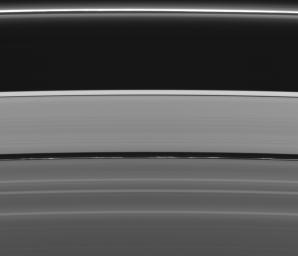
|
Clumps for Encke
- Click the image above for a larger view
- Full-Res JPEG (1003 x 863) (34.5 kB)
- Full-Res TIFF (1003 x 863) (866.7 kB)
Caption:
Squinting at this view of Saturn's rings reveals not one but two of the four narrow ringlets in the Encke Gap (325 kilometers, or 200 miles, wide). The innermost of the two ringlets is much brighter and full of clumps.
The complicated and dynamic features in the Encke Gap are extensively influenced by the presence of Pan (26 kilometers, or 16 miles, across), which orbits in the center of the gap. The Encke Gap may contain other small moonlets, which imaging team members hope to discover in the future.
The image was taken in visible light with the Cassini spacecraft wide-angle camera on Aug. 20, 2005, at a distance of approximately 273,000 kilometers (170,000 miles) from Saturn. The image scale is 13 kilometers (8 miles) per pixel.
Background Info:
The Cassini-Huygens mission is a cooperative project of NASA, the European Space Agency and the Italian Space Agency. The Jet Propulsion Laboratory, a division of the California Institute of Technology in Pasadena, manages the mission for NASA's Science Mission Directorate, Washington, D.C. The Cassini orbiter and its two onboard cameras were designed, developed and assembled at JPL. The imaging operations center is based at the Space Science Institute in Boulder, Colo.
For more information about the Cassini-Huygens mission visit http://saturn.jpl.nasa.gov . For additional images visit the Cassini imaging team homepage http://ciclops.org .
Cataloging Keywords:
| Name | Value | Additional Values |
|---|---|---|
| Target | Saturn Rings | Encke Gap, Pan, Saturn |
| System | Saturn | |
| Target Type | Ring | Gap, Planet, Satellite |
| Mission | Cassini-Huygens | |
| Instrument Host | Cassini Orbiter | |
| Host Type | Orbiter | |
| Instrument | Imaging Science Subsystem (ISS) | |
| Detector | Wide Angle Camera | |
| Extra Keywords | Clump, Grayscale, Moonlet, Visual | |
| Acquisition Date | ||
| Release Date | 2005-09-27 | |
| Date in Caption | 2005-08-20 | |
| Image Credit | NASA/JPL/Space Science Institute | |
| Source | photojournal.jpl.nasa.gov/catalog/PIA07595 | |
| Identifier | PIA07595 | |
